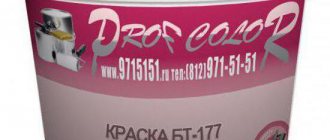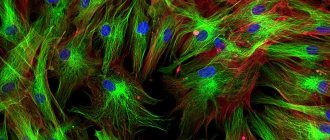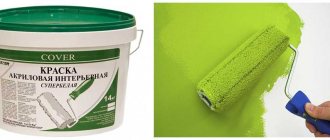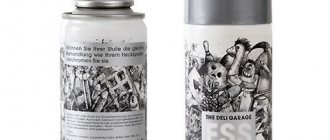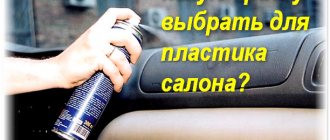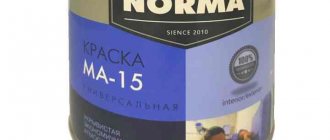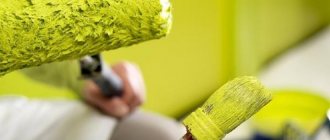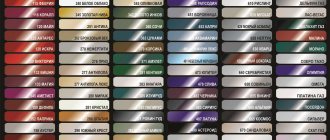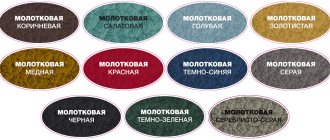It has long been known that when making any purchase, a person is guided more by emotions than by reason. “I want this car, wet asphalt color, period!” The fact remains that, according to a study conducted by the DuPont concern, 40% of buyers are ready to abandon one brand in favor of another if it is painted in the color the buyer likes. As they say, demand creates supply.
Color solutions are also influenced by fashion. For example, today the overwhelming majority of consumers do not prefer a car painted in a single color, but rather one whose paintwork has some kind of “special effect,” even if it is not pronounced. For example, a metallic effect.
Composition of conventional car enamels
Before talking about the features of metallic, it is necessary to remember the composition of ordinary ordinary enamel. It consists of three basic components:
- dye;
- connecting link;
- solvent.
The dye, or pigment, is a composition in the form of a fine powder. This is the component that forms the color of the paint. In addition, pigments may have other properties. Thus, some dyes can additionally protect the body surface from corrosion.
The binder refers to the layer that holds the powdered dye on the surface. When the process is completed and the enamel has dried, it is due to this connecting link that an even shiny layer is formed on the painted surface.
The main task performed by the solvent is to make the paint liquid. This is necessary for more convenient application of it to the body. After all, as a rule, paint is applied using sprayers. Although these components occupy a considerable amount of space in the enamel, its main function is still the dissolution of paint. In addition, after finishing painting, the composition should quickly evaporate from the surface. And often car enamels manufacturers use quickly evaporating liquids as solvents.
We have listed the main components of traditional car enamels, which are used to paint most cars as standard. And then we will look at how metallic paint for cars differs from them.
Preparatory work
Preparing the surface of a part for metallic painting is practically no different from preparing for applying acrylic or alkyd paint, but is associated with a number of difficulties. Preparatory work for metallic painting should be carried out more carefully, since on such paint, and especially on light colors, defects will be visible several times more strongly. Therefore, quality preparation for painting plays an important role in obtaining a good result.
Preparatory work includes the following steps:
- Removing old coating, if any.
- Cleaning the surface of any contaminants.
- Elimination of defects such as dents, scratches, chips using a special putty. It is important here that the color of the putty matches the color of the paint that you plan to apply.
Preparatory work should be carried out more carefully before metallic painting
- Sanding with sandpaper to obtain a smoother surface. This stage of work is carried out after the applied putty has dried.
- Removing dust and degreasing. Dust is usually removed by blowing on all necessary parts, after which the surface is degreased using anti-silicone liquid. You should also wipe the surface with a sticky cloth to remove any remaining dust.
Metallic auto enamel: composition
The paint described differs from the traditional one in its more complex composition. The standard one, as already mentioned, contains three components: dye, “base” and solvent. But in this enamel, along with the three named components, there is one more component - aluminum powder.
When its small particles are mixed with paint, a metallic sheen effect is created. This is the first reason why metallic is chosen - the paint really looks very impressive.
Aluminum powder particles reflect light rays, creating a glowing effect. However, you have to pay for beauty. The technology of coating with such paint is much more complicated than with conventional compositions. The enamel should lie on the surface in an even layer. If the composition is applied unevenly, stains will appear. And the problem is that such stains will be more noticeable on this paint.
There is one more property that distinguishes metallic - the paint, due to the content of aluminum powder in it, protects the color from fading and the body from corrosion. The cost of a car painted with it is higher due to the more complex mixture used to coat the body, as well as due to the rather complex application technology.
Flop effect
So, the main feature of metallics is the manifestation of an element of metallic shine on the paintwork. But the “effectiveness” of these paints does not end there.
If you look at a car painted metallic from different angles, you can clearly see that the intensity of this shine is not constant - it is sometimes greater, sometimes less. Indeed, any “metallic” looks different depending on the viewing angle: at a certain moment the coating glows brightly, sparkles, and then gradually darkens as the viewing angle changes (for example, when a car turns). These changes, from light to dark and back again, are called the flop effect.
Let's try to figure out why this happens.
As we have already said, the surface of a metal pigment plays the role of a mirror that reflects light rays incident on it according to the laws of geometric optics (the angle of reflection is equal to the angle of incidence). And if the aluminum particles are located in the paint layer as needed, that is, parallel to the surface, then when viewed from the front, the paint is perceived as lighter, since in this case we see more light reflected by the grain.
If you look at the surface from the side, at an acute angle, the intensity of the reflected light decreases greatly and the paint is perceived as darker. In this case, reflection from color pigments predominates.
In other words, when light hits a paint surface, some of the light is reflected by the pigment (color) and some by the aluminum grain (brightness). And depending on the viewing angle, we see either a reflection from the pigments or from the grain.
The color tone that is visible when looking at a surface at a 90° angle (for example, the hood) is called " face " (or top tone).
And the tone we see when we look at a surface at an acute angle (for example, the sides of a car) is called “ flop ” (or bottom tone).
Flop and flip are the same thing - changing shade at an acute angle.
The presence of these two different tones in metallic causes additional difficulties in color selection, since the colorist is forced to select both of these tones. The top metallic tone is always selected first, and only then the bottom tone. There are many ways to change these tones individually.
For example, adding a small amount of “silver” only lightens the top tone. Large amounts of silver lighten both tones, but large particles have less effect on the shade visible on the side of the car than small ones. Adding plain white in small amounts (up to 5%) lightens the bottom tone. When white is added in large quantities, the metallic effect becomes weaker. In short, there are countless subtleties when choosing colors.
Aluminum particles are often called silver because of their characteristic silvery color.
In addition, the shade of enamels with aluminum grain greatly depends on the conditions and method of application. The type of spray gun, nozzle diameter, working pressure, paint viscosity, distance and shape of the spray torch, thickness of the applied layer - all this can affect the shade.
So for a good result when working with spectacular colors, you will need a combination of a competent and diligent colorist, a knowledgeable and experienced painter and... luck. A painter can either ruin the good work of a colorist or “pull out” the color by imperceptibly painting a part with a “transition” even with paint that is very roughly tinted.
Operating principle
Metallic paint works based on the principle of light reflection. The small aluminum shavings contained in its composition act as microscopic mirrors. The particles reflect the light that falls on them. This, as we have already mentioned, causes the characteristic metallic shine.
In addition to the pigments that create these effects, paints also contain color components that provide shade. Unlike single-color car enamels, where light-proof dyes are used, in metallics it is necessary to use light-permeable substances. Aluminum powder is in a dye environment. Thus, only a transparent pigment allows light rays to reach the aluminum and be reflected in the powder.
The principle of operation can be boiled down to the fact that light hitting the surface of the paintwork passes through translucent paint, resulting in the formation of rays of a certain color. Next they fall on aluminum. Then they are reflected and again pass through the translucent paint to the outside. Therefore, not only the color of the car is visible, but also a special sparkling visual effect is observed. This is how metallic works. The paint is not only beautiful, but also practical.
Printing pigments
For different printing methods, pigment is used from the same metal raw material, but with particles of different sizes. For offset and letterpress printing, flakes with a thickness of about 0.1 microns and a diameter of 3.5 microns are needed. And for gravure and flexographic printing, polished particles with the same thickness have a diameter of 8 to 9 microns. It would seem that the easiest way to increase shine is to use a pigment with enlarged particles. But for good covering properties in the paint, it is necessary to maintain a sufficiently high pigment content, and an increase in the size of metal particles leads to a weakening of the action of binders and settling, precipitation of bronze or aluminum pigments.
The shelf life of finished paint is sharply reduced. In gravure printing, the presence of particles larger than 10 microns in ink leads to the formation of absorption and other defects on the print - mainly due to unwanted accumulation of ink behind the squeegee. Such layers of paint “pop out” from under the knife from time to time, significantly worsening the quality of the finished product. It follows that in metallic printing inks particles of arbitrary sizes cannot be used, and when combining, a certain balance must be maintained.
Dry metal powder is transformed into ink suitable for printing processes thanks to the binders that envelop and carry each pigment particle. The powder is slightly moistened beforehand to facilitate subsequent mixing. Naturally, the composition of binders for inks intended for different printing methods is different. The composition of firnis (prepared binders) for offset inks includes solid resins (modified rosin and/or hydrocarbon resin), plant-based alkyd resin, mineral oil thinner, vegetable oils, structure formers. Ink binders used in gravure printing include cellulose derivatives (nitrocellulose, ethylcellulose, cellulose acetate butyrate and cellulose acetopropynate), polyamide resins, vinyl copolymers and other resins.
From bicycle to car
A similar composition in the USSR was not used on car bodies. In the USSR, “Victory” and “Volga” cars were treated with simple colors - white, gray, beige. Metallic came to the big country on bicycle frames produced in Kharkov. The frames sparkled with aluminum powder, reflecting rays of light from under a thick film of enamel. It was nothing more than a first generation single coat metallic. It differed in that aluminum powder was contained throughout the entire thickness of the paint, which was approximately 50 microns.
Judging by the reviews, this paint was considered interesting back then. But many were put off by its weak resistance to various influences. During use, it also wore out - the powder oxidized and went with the wind. The surface acquired dull white shades. In order to avoid this, experts have developed a two-layer system. A clear varnish was applied over the paint.
This is how two-layer metallic was born. The paint turned out to be more durable and durable, as well as effective. The varnish served as a magnifying glass. Then the paint began to be used for cars.
Color options
Painting a car in metallic color is carried out taking into account certain features. Thus, it is necessary to monitor not only the uniformity of distribution or quality of coloring, but also the thickness and number of layers. There are several material options:
- single-layer metallic – this type contains varnish, but the painting can be spoiled by the appearance of smudges or bubbles;
- two-layer – painting occurs in two stages with an interval for the first layer to dry, resulting in a shiny coating that is resistant to mechanical stress and damage;
- three-layer metallic - the result of this option is a pearlescent sheen.
The most common method for painting a car is the two-layer method. Whereas technically complex is a three-layer coating intended for non-standard painting options.
Black metallic: paint features
Black metallic, like white and silver, is now one of the most popular. By the way, psychologists are sure that this color is chosen by people with leadership qualities, respectability and good taste. Due to their special representativeness, black cars are especially popular in Germany, Europe, and Russia.
This color is also considered the best background for creating inscriptions. Any airbrush looks very expensive and impressive on a black background.
Metallic car paint, unlike traditional ones, has a higher level of body protection. A car treated with such enamel has better protection against fading, corrosion and chipping. And at the same time, owners of black cars complain that after just a few months of using the car, a so-called cobweb appears on the surface of the car, as well as abrasions. In addition, black color reduces the size of the car (of course, only visually). Black metallic bodywork requires polishing more often than any other.
Color palette
The full metallic color range is varied. Among the classic shades, car enthusiasts choose silver, silver-black, and white metallic. Unusual shades are considered to be half-tones of red: silver-light orange, silver-bright red, golden-red. These shades are designated by the names: “apricot”, “accord”, “coriander”, respectively.
The color scheme allows you to create different shades:
- white tone creates the effect of pearl radiance;
- black metallic provides an even, rich finish;
- bright colors with a metallic sheen look muted.
Gray color: features
Along with black cars, silver cars are especially popular, regardless of the functionality and prestige of a particular brand. These trends are true not only when buying a car from a showroom, but also when selling it. The main reason why people choose gray is, of course, its high practicality. According to reviews, the metallic gray paint does not mark, and the car can be washed less often. Dust is not so visible on it. And any splashes and drops of dirt merge with the color of the body.
Silver color is the color of high technology, progress and innovation. The driver expects from such a car spectacular equipment and attention from others. Many people associate this color with high cost and presentability.
Binders for pigments
In total, at least a thousand types of binder components are used in the production of paints. It is clear that the number of possible combinations is infinite. That is why so many series of paints have been developed, different in their properties, although initially there were only two pigments for metallized paints. The composition changes, the proportions of components change, the properties of the product change. Naturally, first of all, when creating a paint composition, the printing method is taken into account. Thus, inks for letterpress and offset printing must be much more viscous than inks for gravure and flexographic printing. And here the choice of solvent and determination of its proportion becomes crucial.
Silver metallic: features
According to car enthusiasts, if silver metallic paint is applied to the body, the car will not lose its color when exposed to sunlight and will not overheat. Even scratches are barely noticeable in this shade. This coating, which shimmers in the sun, looks very rich. And as a nice bonus - additional body protection.
Silver color, according to most, looks expensive and prestigious.
If you don’t like too conservative black, then, as experts advise, gray or silver can perfectly replace it. This is a neutral shade. It is well suited for both a family car and a purely female or male one.
